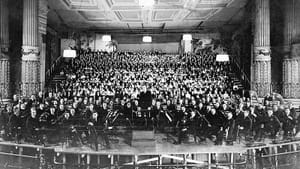Stay in the Loop
BSR publishes on a weekly schedule, with an email newsletter every Wednesday and Thursday morning. There’s no paywall, and subscribing is always free.
Preserving Philly’s classical musical heritage
The Academy of Music and the Philadelphia Orchestra’s archives get a new home at the University of Pennsylvania Libraries

Philadelphia’s Musical Fund Hall, which opened in 1824 on Locust Street west of Eighth Street, had served the city as a music venue for many years, but as the popularity of opera grew, it was clear that a larger venue was needed to accommodate grand opera productions.
The first known meeting to attempt to build an opera house was held on November 9, 1839, at the Marshall House, 207 Chestnut Street. A Charter and Prospectus of the Opera House, or American Academy of Music was printed in 1852. After many trials and tribulations, subscribers were secured, architects Gustav Rungé and Napoleon LeBrun were hired, the work begun, and the grand inaugural opening was held on January 26, 1857.
Imagine Philadelphia’s Broad Street on the Academy’s inaugural evening in 1857. If you stood with your back to the Academy of Music and looked to your left, you would have seen nothing. Were it daytime, you would have seen the trees and grass of Centre Square with its waterworks facility. In 1857, Philadelphia’s City Hall was located at Fifth and Chestnut Streets. The City Hall we know in 2023 was not even a gleam in an architect’s eye.
The Philadelphians are born
There was no Philadelphia Orchestra in 1857, either. There were local orchestras and many visiting orchestras. An amateur orchestra called the Philadelphia Symphony Society had many supporters who were devoted to the city’s musical life. When, in 1899, Mrs. Frederick N. Innes heard conductor Fritz Scheel’s group play in Fairmount Park, the die was cast. He was hired to conduct the Philadelphia Symphony Society’s three annual concerts and also hired to conduct spring concerts with exclusively professional musicians. He hired Vladimir de Pachmann and Édouard de Reszke as soloists for two concerts to benefit the widows of soldiers and sailors of the Philippine War. The concerts were such a success that funds were raised and Scheel was hired to conduct the first performance of the Philadelphia Orchestra on November 16, 1900.

Making treasures accessible
When Matías Tarnopolsky took his position as president and CEO of the Philadelphia Orchestra in 2018, he was awed by the treasures contained in the archives of the Academy of Music, but he also realized there were disadvantages. “As beautiful as that room upstairs was, it was not easily accessible to anyone who was really deeply interested in knowing the story of the Philadelphia Orchestra and what the Philadelphia Orchestra means as a defining institution in Philadelphia.”
Now those materials will be accessible. After they are processed, the archives will go to the Penn Libraries’s Kislak Center for Special Collections, Rare Books and Manuscripts in the Van Pelt-Dietrich Library Center at 3420 Walnut Street. The center already has the personal papers of Philadelphia Orchestra conductors Leopold Stokowski (1882-1977) and Eugene Ormandy (1899-1985). Now, researchers will also be able to trace the story of how the oldest continually operating opera house in the United States came into being, along with the life story of the Philadelphia Orchestra.

On the orchestra train
I have visited there to research the Musical Fund Society, Marian Anderson, and Francis Johnson. While researching for this article, I made an appointment to examine some of the personal papers of Stokowski and Ormandy. I discovered notes, old programs, letters, annotated orchestral scores, and even scrapbooks which had been collected and given to the conductors by patrons.
One notable find was a souvenir program dated 1937 entitled RCA Victor presents the Philadelphia Orchestra Second Transcontinental Tour. The orchestra travelled in its own train where musicians lived during their tour. It had six sleepers, two baggage trucks, one club-observation car, and a diner. There were shower baths, sleeping berths, easy chairs, writing desks, dining tables, kitchens, and clothes compartments. The train carried 100 orchestra members and 12 officials. According to the notes written by Alfred Reginald Allen, manager of the Philadelphia Orchestra, they travelled 11,000 miles, gave 24 concerts, and had audiences totaling 250,000.
“These archives are an invaluable resource for scholars and a treasured part of the cultural life of the city of Philadelphia,” said Penn President Liz Magill. “Through this unique partnership, Penn is helping to preserve these materials and provide access that will spur new research in music, history, architecture, and other fields. We are honored to have the Penn Libraries serve as home to these important historical treasures.”
Sign up for our newsletter
All of the week's new articles, all in one place. Sign up for the free weekly BSR newsletters, and don't miss a conversation.

 Margaret Darby
Margaret Darby